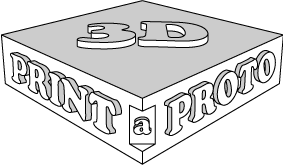Ready to turn your designs into reality?
We just need a little information
Use this form to enter your info and upload any files. We will contact you directly to go over the details.
Exporting to a .STL File per CAD System
Alibre
- File
- Export
- Save As > STL
- Enter File Name
- Save
Ashlar-Vellum
- File > Export...
- Select STL Export Type
- Set Export Options to Binary > OK
- Enter Filename
- Save
AutoCAD
Your design must be a three-dimensional solid object to output an STL file.
-
- Make sure the model is in positive space
- At the command prompt type “FACETRES”
- Set FACETES BETWEEN 1 & 10. (1 Being low resolution and 10 high resolution for STL Triangles).
- Next, at the command prompt type “STLOUT”
- Select Objects
- Choose “Y” for Binary
- Choose Filename
Autodesk Inventor
-
- Save Copy As
- Select STL
- Choose Options > Set to High
- Enter Filename
- Save
CADKey
- Choose Stereolithography from Export options
- Enter Filename
- Click OK
I-DEAS
- File > Export > Rapid Prototype File > OK
- Select the Part to be Prototyped
- Select Prototype Device > SLA500.dat > OK
- Set absolute facet deviation to 0.000395
- Select Binary > OK
IronCAD
- Right Click on the part
- Part Properties > Rendering
- Set Facet Surface Smoothing to 150
- File > Export
- Choose .STL
Mechanical Desktop
- Use the AMSTLOUT command to export your STL file.
- The following command line options affect the quality of the STL and should be adjusted to produce an acceptable file.
- Angular Tolerance - This command limits the angle between the normals of adjacent triangles. The default setting is 15 degrees. Reducing the angle will increase the resolution of the STL file. Setting of 1 would mean the height of a facet is no greater than its width. The default setting is 0, ignored.
- Aspect Ratio - This setting controls the Height/Width ratio of the facets.
- Surface Tolerance - This setting controls the greatest distance between the edge of a facet and the actual geometry. A setting of 0.0000 causes this option to be ignored.
- Vertex Spacing - This option controls the length of the edge of a facet. The default setting is 0.0000, ignored.
ProE
- File > Export > Model (or File > Save a Copy)
- Set type to STL
- Set chord height to 0. The field will be replaced by minimum acceptable value.
- Set Angle Control to 1
- Choose File Name
- OK
ProE Wildfire
- File > Save a Copy > Model
- Change type to STL (*.stl)
- Set Chord Height to 0. The field will be replaced by minimum acceptable value.
- Set Angle Control to 1 5. OK
Rhino
- File > Save As Select File Type > STL
- Enter a name for the STL file.
- Save
- Select Binary STL Files
SolidDesigner
- File > Save
- Select File Type > STL
- Select Data
- Click OK
ScanIP
- File > Export > STL...
- Select parts for export and export settings
- Export
- Enter Filename
- Save
SolidEdge
- File > Save As
- Set Save As Type to STL
- Options
- Set Conversion Tolerance to 0.001in or 0.0254mm
- Set Surface Plane Angle to 45.00
- Save
SolidWorks
- File > Save As
- Set Save As Type to STL
- Options > Resolution > Fine > OK
- Save
Think3
- File > Save As
- Set Save As Type to STL
- Save
Unigraphics
- File > Export > Rapid Prototyping
- Set Output type to Binary
- Set Triangle Tolerance to 0.0025
- Set Adjacency Tolerance to 0.12
- Set Auto Normal Gen to On
- Set Normal Display to Off
- Set Triangle Display to On
